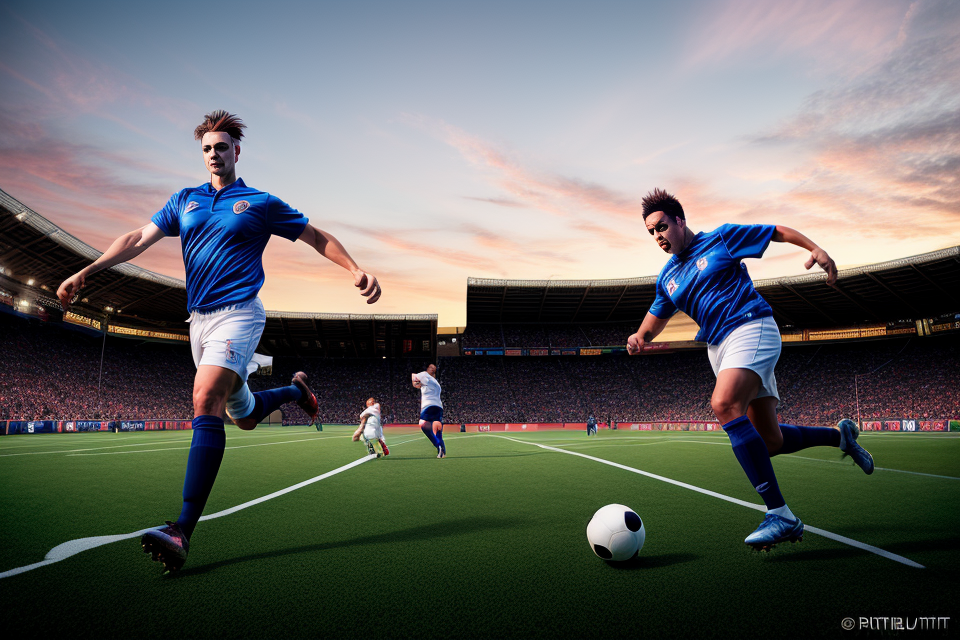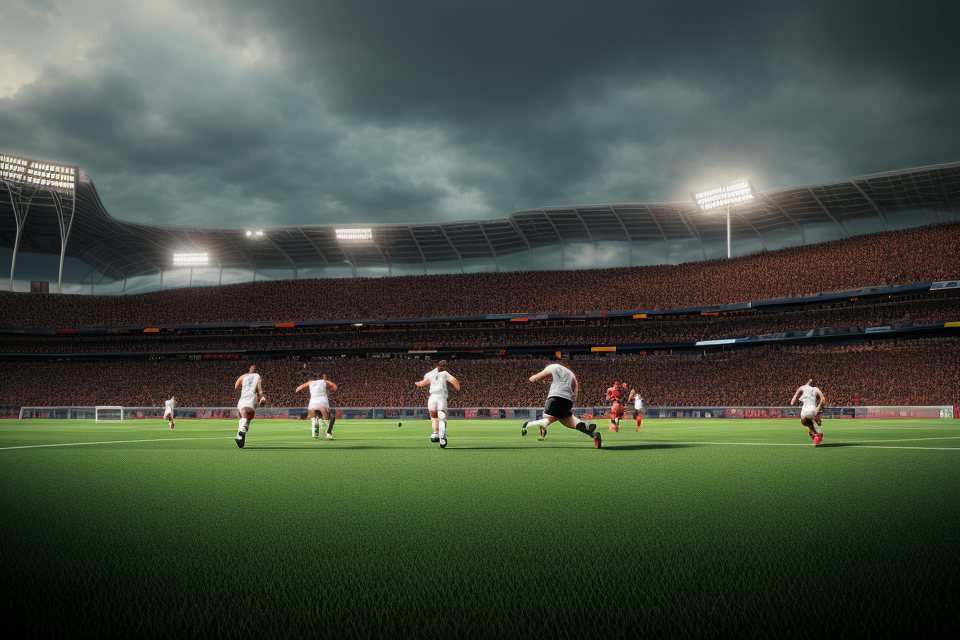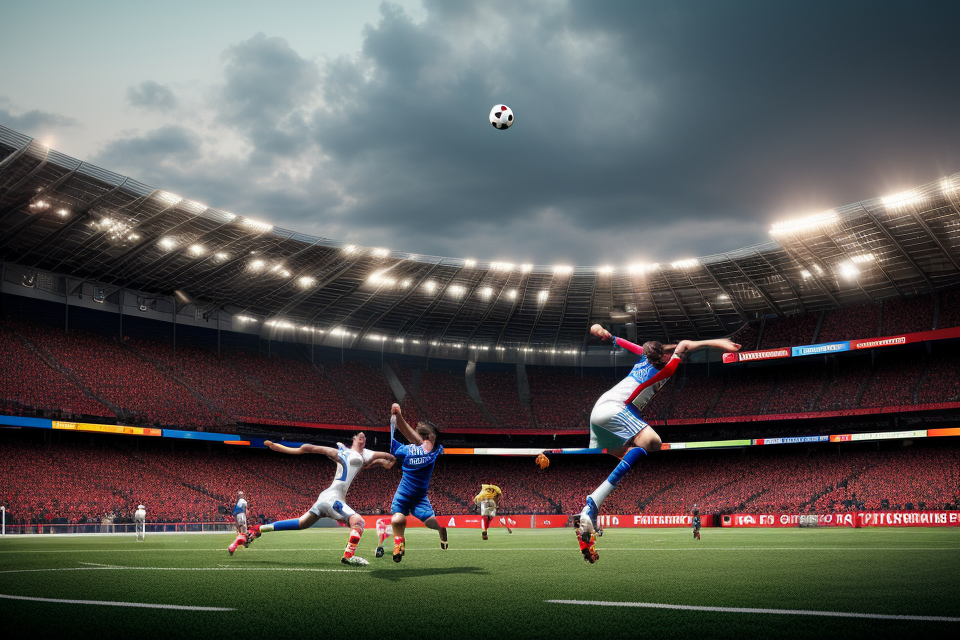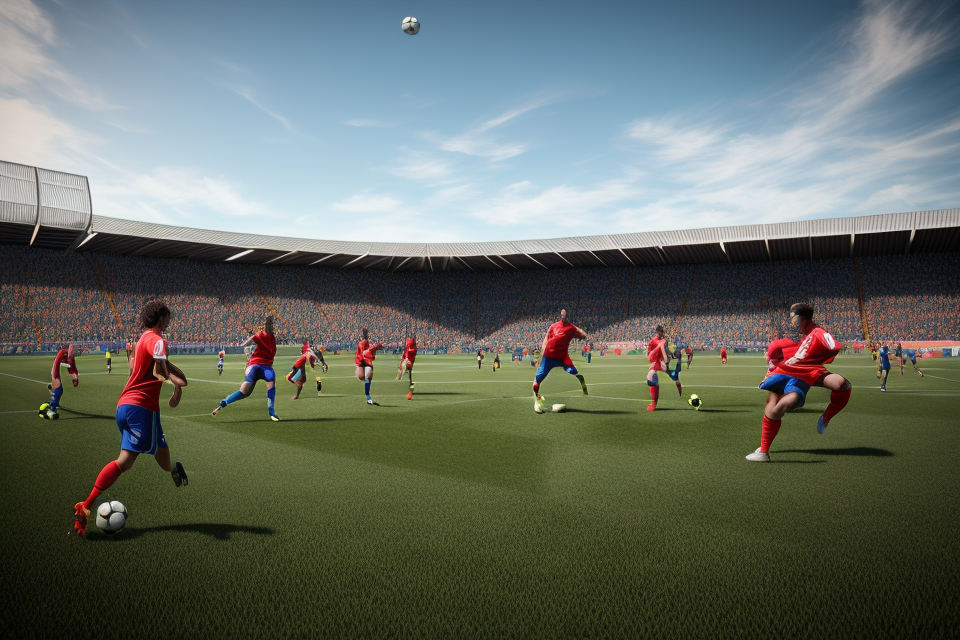Soccer is a sport that demands athleticism in its truest form. To be a successful soccer player, one must possess a combination of strength, speed, endurance, agility, and coordination. Achieving peak athleticism in soccer requires a dedicated training program that focuses on improving these key attributes. In this comprehensive guide, we will explore the various exercises and techniques that can help you enhance your athleticism in soccer. From strength and conditioning exercises to drills that improve agility and coordination, this guide has everything you need to take your soccer game to the next level. So, let’s get started and discover how you can achieve peak athleticism in soccer!
Developing Physical Fitness
Cardiovascular Endurance
- Cardiovascular endurance is a critical aspect of physical fitness in soccer, as it enables players to perform at high intensity levels for extended periods of time without fatiguing.
- To improve cardiovascular endurance, players should engage in regular aerobic exercises such as running, cycling, or swimming.
- These exercises should be performed at a moderate to high intensity level, with the goal of increasing the duration and intensity of the workout over time.
- Additionally, incorporating interval training, which involves alternating periods of high-intensity exercise with periods of rest or low-intensity exercise, can be an effective way to improve cardiovascular endurance.
- Soccer-specific drills such as shuttle runs, beep tests, and yo-yo intermittent recovery tests can also be used to assess and improve cardiovascular endurance.
Strength and Power
- Strength and power are essential for success in soccer, as they enable players to perform physical tasks such as dribbling, passing, and shooting with greater efficiency and force.
- To improve strength and power, players should engage in resistance training exercises such as weightlifting, plyometrics, and bodyweight exercises.
- These exercises should target the major muscle groups used in soccer, including the legs, core, and upper body.
- It is important to progressively increase the resistance and intensity of the exercises over time to continue improving strength and power.
- Additionally, incorporating explosive exercises such as jumps and plyometric bounds can help improve power and explosiveness.
Flexibility and Mobility
- Flexibility and mobility are crucial for preventing injury and maintaining optimal performance in soccer.
- To improve flexibility and mobility, players should engage in regular stretching and mobility exercises.
- These exercises should target the major muscle groups used in soccer, including the hamstrings, quadriceps, and hip flexors.
- Dynamic stretching, which involves moving while stretching, can be more effective than static stretching for improving flexibility and mobility.
- Incorporating yoga and Pilates exercises can also be beneficial for improving flexibility and mobility.
- Additionally, foam rolling and self-myofascial release techniques can help to release tension in the muscles and improve mobility.
Improving Skills and Techniques
Ball Control
In soccer, ball control is a crucial aspect of the game that involves the ability to handle the ball with precision and accuracy. Good ball control allows players to maintain possession of the ball, make successful passes, and create scoring opportunities.
To improve ball control, players can practice a variety of exercises that focus on different aspects of the skill, such as dribbling, receiving, and controlling the ball with different parts of the body. These exercises can be incorporated into a player’s training routine to help them develop better ball control.
Dribbling
Dribbling is another important skill in soccer that involves the ability to move the ball past opponents while maintaining control of it. Good dribbling skills allow players to create space and make successful runs towards the goal.
To improve dribbling skills, players can practice a variety of exercises that focus on different aspects of the skill, such as close control, speed, and agility. These exercises can be incorporated into a player’s training routine to help them develop better dribbling skills.
Shooting
Shooting is a crucial skill in soccer that involves the ability to score goals. Good shooting skills allow players to make the most of their scoring opportunities and contribute to their team’s success.
To improve shooting skills, players can practice a variety of exercises that focus on different aspects of the skill, such as accuracy, power, and technique. These exercises can be incorporated into a player’s training routine to help them develop better shooting skills.
Nutrition and Recovery
Proper Nutrition
Proper nutrition is essential for athletic performance in soccer. The right nutrients provide the necessary energy and support for physical and mental functions required for optimal performance. In addition, proper nutrition helps with muscle recovery, reduces the risk of injury, and supports overall health.
Here are some foods to eat for optimal soccer performance:
- Complex Carbohydrates: Foods such as whole grains, fruits, and vegetables provide sustained energy and support muscle recovery.
- Protein: Foods like lean meats, fish, beans, and nuts are important for muscle repair and growth.
- Healthy Fats: Foods such as avocados, nuts, and seeds provide essential energy and support overall health.
- Hydrating Drinks: Water and sports drinks are important for maintaining hydration during soccer matches and training sessions.
It is important to develop a balanced diet that meets the unique nutritional needs of soccer players. A balanced diet should include a variety of foods from different food groups to ensure that all necessary nutrients are obtained.
Recovery Techniques
Recovery is crucial for improving athleticism in soccer. Recovery techniques help to reduce muscle soreness, prevent injury, and improve overall performance.
Here are some recovery techniques for soccer players:
- Rest and Recovery: Adequate rest and recovery time is essential for muscle repair and growth. Soccer players should aim for at least 7-9 hours of sleep per night.
- Stretching and Foam Rolling: Stretching and foam rolling help to reduce muscle soreness and improve flexibility.
- Massage Therapy: Massage therapy can help to reduce muscle soreness and improve circulation.
- Hydration: Proper hydration is important for recovery and preventing injury.
- Nutrition: A balanced diet that includes foods rich in protein, carbohydrates, and healthy fats can aid in recovery.
It is important to develop a recovery plan that is tailored to individual needs and preferences. A recovery plan should include a combination of recovery techniques to optimize performance and prevent injury.
Mental Toughness and Resilience
Building Mental Toughness
In soccer, mental toughness is a crucial factor that determines a player’s ability to perform under pressure and adversity. It is the ability to maintain focus, composure, and determination in the face of challenges and setbacks. Developing mental toughness can help players overcome obstacles, bounce back from defeats, and achieve their goals.
To build mental toughness, players can engage in exercises that help them develop focus, self-confidence, and resilience. One such exercise is visualization, where players imagine themselves performing well in high-pressure situations. Another exercise is positive self-talk, where players replace negative thoughts with positive affirmations.
Players can also incorporate mental toughness exercises into their soccer training regimen. For example, they can practice handling difficult situations during practice games or simulate high-pressure scenarios during drills. By doing so, players can build their mental toughness and develop the ability to perform under pressure.
Overcoming Adversity
In soccer, adversity is inevitable, and players will encounter setbacks and challenges throughout their careers. However, developing resilience can help players bounce back from injuries, losses, and other setbacks. Resilience is the ability to recover quickly from difficult situations and maintain a positive outlook.
To develop resilience, players can focus on maintaining a positive mindset, seeking support from teammates and coaches, and learning from setbacks. Players can also engage in physical activity, such as yoga or meditation, to help them manage stress and anxiety.
In addition, players can learn from successful athletes who have overcome adversity. By studying their experiences and strategies, players can develop their own coping mechanisms and learn how to bounce back from setbacks.
Overall, mental toughness and resilience are essential components of achieving peak athleticism in soccer. By developing these skills, players can overcome challenges, perform under pressure, and achieve their goals.
Developing Soccer-Specific Speed and Agility
Agility Drills
In soccer, the ability to quickly change direction and move with precision is crucial for success on the field. Agility drills are designed to improve a player’s footwork, balance, and body control, which can help them evade opponents and make split-second decisions on the ball.
Agility drills for soccer players can include exercises such as cone dribbling, shuffle drills, and ladder drills. These drills involve moving around cones or other obstacles while maintaining control of the ball, and can be customized to different levels of difficulty based on the player’s skill level.
To incorporate agility drills into your soccer training, it’s important to start with a warm-up to prevent injury and then gradually increase the intensity and complexity of the drills over time. It’s also important to focus on proper form and technique to ensure that the exercises are effective and safe.
Speed Training
Speed is a crucial component of soccer, as it allows players to quickly move up and down the field and make fast-paced plays. Speed training exercises for soccer players can include activities such as sprinting, plyometrics, and interval training.
Sprinting is a great way to improve speed and endurance, and can be done on a track or field. Plyometrics, or jump training, involves explosive movements such as box jumps and bounding, which can help improve power and explosiveness. Interval training involves alternating between periods of high-intensity exercise and periods of rest, and can be customized to different levels of fitness.
To incorporate speed training into your soccer training, it’s important to start with a warm-up and gradually increase the intensity and duration of the exercises over time. It’s also important to focus on proper form and technique to prevent injury and ensure that the exercises are effective. Additionally, incorporating speed training into your overall fitness routine can help improve your overall athleticism and performance on the field.
Building Endurance and Stamina
Interval Training
- The importance of interval training in soccer
Interval training is a highly effective method for improving endurance and stamina in soccer players. It involves alternating periods of high-intensity exercise with periods of rest or active recovery. This type of training is particularly useful for soccer players because it simulates the demands of a match, where players are required to perform at a high intensity for short periods of time, followed by periods of lower intensity or recovery.
- Interval training exercises for soccer players
Interval training exercises for soccer players can include sprint intervals, where players sprint for a set distance or time, followed by a period of rest or active recovery, such as jogging or walking. Another example is interval hill sprints, where players sprint up a hill or incline, followed by a period of rest or active recovery.
- How to incorporate interval training into your soccer training
Interval training can be incorporated into a soccer player’s training program in a variety of ways. For example, it can be done as part of a regular training session, or as a separate session on its own. It is important to gradually increase the intensity and duration of the interval training over time to avoid injury and to ensure progressive overload.
Aerobic Endurance
- The importance of aerobic endurance in soccer
Aerobic endurance is the ability of the body to deliver oxygen and nutrients to the working muscles during sustained exercise. It is a critical component of soccer performance, as matches can last up to 90 minutes or more, and players are required to perform at a high intensity for extended periods of time.
- Aerobic endurance exercises for soccer players
Aerobic endurance exercises for soccer players can include long-distance running, cycling, or swimming. These exercises can be done at a moderate to high intensity to improve cardiovascular fitness and endurance.
- How to incorporate aerobic endurance exercises into your soccer training
Aerobic endurance exercises can be incorporated into a soccer player’s training program in a variety of ways. For example, they can be done as part of a regular training session, or as a separate session on its own. It is important to gradually increase the intensity and duration of the aerobic endurance exercises over time to avoid injury and to ensure progressive overload. Additionally, incorporating interval training into aerobic endurance exercises can further improve endurance and stamina in soccer players.
FAQs
1. What are the key components of athleticism in soccer?
The key components of athleticism in soccer include speed, agility, endurance, strength, power, and flexibility. To improve your athleticism in soccer, it is important to focus on training that develops these components.
2. How can I improve my speed in soccer?
To improve your speed in soccer, you should incorporate training that includes sprinting and interval training. You can also improve your speed by practicing changes of direction and working on your footwork. Additionally, it is important to maintain a healthy diet and stay properly hydrated to support your speed and overall athleticism.
3. How can I improve my agility in soccer?
To improve your agility in soccer, you should incorporate training that includes drills that require quick changes of direction, such as ladder drills and cone drills. You can also improve your agility by practicing footwork and working on your ability to stop and start quickly. Additionally, it is important to maintain good body control and balance to support your agility on the field.
4. How can I improve my endurance in soccer?
To improve your endurance in soccer, you should incorporate training that includes aerobic exercise, such as running and cycling. You can also improve your endurance by practicing interval training and working on your ability to maintain a high level of intensity over a long period of time. Additionally, it is important to maintain a healthy diet and stay properly hydrated to support your endurance and overall athleticism.
5. How can I improve my strength in soccer?
To improve your strength in soccer, you should incorporate training that includes weightlifting and resistance training. You can also improve your strength by practicing exercises that target the muscles used in soccer, such as squats and lunges. Additionally, it is important to maintain a healthy diet and stay properly hydrated to support your strength and overall athleticism.
6. How can I improve my power in soccer?
To improve your power in soccer, you should incorporate training that includes explosive exercises, such as plyometrics and jumps. You can also improve your power by practicing exercises that target the muscles used in soccer, such as medicine ball slams and kettlebell swings. Additionally, it is important to maintain a healthy diet and stay properly hydrated to support your power and overall athleticism.
7. How can I improve my flexibility in soccer?
To improve your flexibility in soccer, you should incorporate stretching and flexibility training into your routine. You can also improve your flexibility by practicing yoga and other forms of mind-body exercise. Additionally, it is important to maintain good posture and body control to support your flexibility on the field.
8. How important is nutrition and hydration for improving athleticism in soccer?
Nutrition and hydration are essential for supporting athletic performance in soccer. It is important to maintain a healthy diet that includes a balance of nutrients, such as carbohydrates, proteins, and healthy fats. Additionally, it is important to stay properly hydrated before, during, and after training and games to support your energy levels and overall athleticism.



